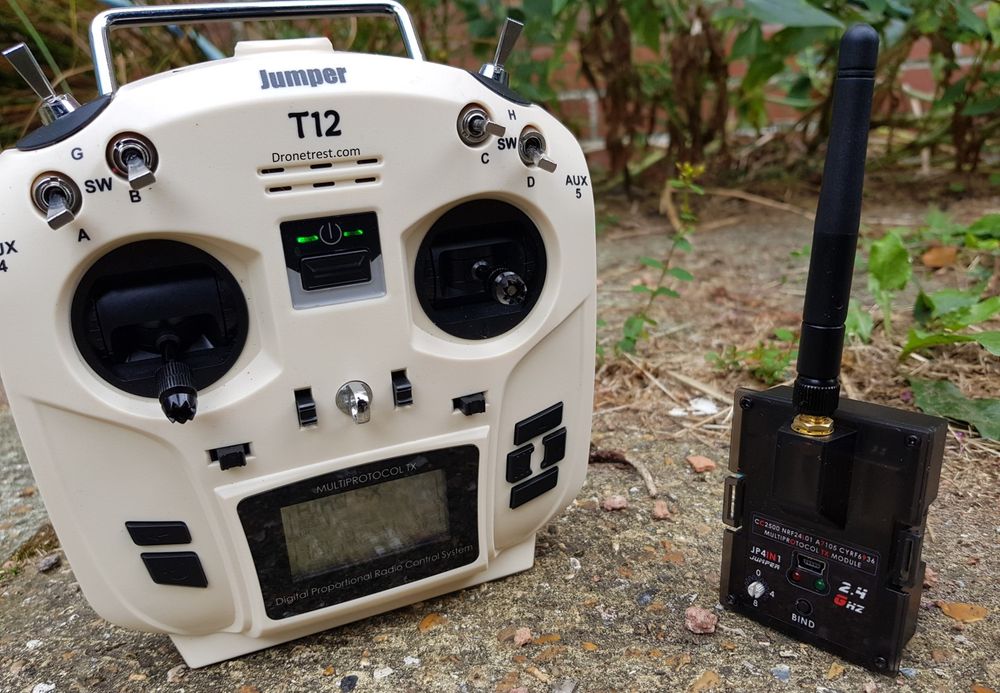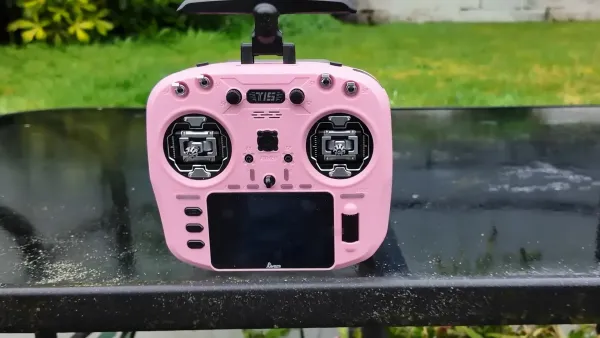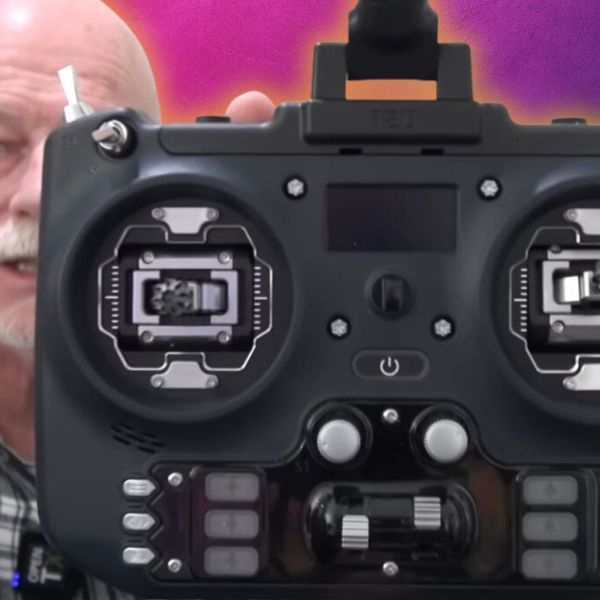What happens when you take the multiple-protocol capable Jumper T8, squeeze in OpenTX, remove the garish yellow (Yes!) and replace it with… cream? Well, what happens is that I, an avid FrSky radio advocate, get a new go-to radio – but is it perfect? Want to know the nitty gritty? Read on!
Jumper T12 Multi-Protocol
Quick Review
At-A-Glance:
The Good
- Runs OpenTX (same as X9D+, Qx7…)
- Multi-Protocol support (Lots!)
- Small and Portable
- Cream is better than yellow? (it’s really not so bad)
- Plenty of AUX options
- CrossFire TX compatible out of the box (TX sold separately)
- Updated rear of case includes ‘grips’
- Affordable (competitive) Pricing
- LUA support
- External Full-sized Module Bay
The Bad
- It’s small, feels light in the hand; some may not like that
- Some hand placements can feel uncomfortable (fingertips touch on rear of TX)
- Annoying firmware controls (Buttons seem counter-intuitive)
- Some may not like colour
- No hall gimbals, if that bothers you
- Tinny sounding speaker
- Picking the right protocol can take a short while
Summary
This little radio is very impressive – especially when you consider the price. To sum it up in a word, this cream-wearing TX from Jumper is just… Convenient. Being able to pick up nearly any quad with the confidence that you can fly it as long as it has a binding procedure, combined with the open nature and vast online support for the OpenTX firmware is an outstanding benefit to have sub-£100 , let alone sub £80 (ATOW). If you need something that will (after a much smaller learning curve than the previous T8 line) just work, and leave you with total freedom over your kit; the Jumper T12 will not disappoint. The minor downsides such as the silly firmware controls are massively outweighed by the vibrant feature set offered in this incredibly portable bit of kit.
Who is the Jumper T12 for?
- Beginners who don’t want the hassle of picking a specific receiver
- Anyone on a budget
- Intermediate-pro flyers who don’t miss hall gimbals and need or want something portable, practical, functional and convenient
- Me – this is now my daily go-to TX (swapped out my QX7)
Where to Buy

Full Written Review
For those who like more depth and detail.
A Little Background…
My previous radio was a QX7 – and I loved it. Having held the X9D+, I can say for certain that I prefer the QX7. It’s more lightweight, and way more comfortable in the hand to me. But recently, since Jumper sent through this review unit to us, I can’t stop picking up the T12 to either fly or fiddle with. It’s just so… Convenient.
Convenience! (Multi-Protocol Feature)
Let’s get straight to the point: The T12 has a killer feature, one that I have come to adore. The ability to just pick and choose which protocol I need and the resulting freedom when shopping around for receivers is an absolute godsend. It comes in the form of an included module – there’s no RF module built in to the radio unlike past generations. Still, I am free to pick up practically any quad knowing full well that I will be able to fly it on the same radio I fly my go to freestyle build with. It’s strange, it’s something that I didn’t even consider a problem until it was solved. No longer am I disheartened when I see the R-XSR is out of stock and I’ve lost or broken mine (you’d be surprised how often this sort of thing happens to me) – I can use anything. It’s really quite an awesome feature to have, and, to avoid rambling for too long, let’s just say it’s a very big plus in my books.
Now, those of you familiar with Jumper’s line up might find yourselves saying:
“But Cameron, the T8SG has had this for ages!”
To which I reply; yes – but it never had the next killer thing on the spec sheet:

OpenTX!
Jumper really made a smart move here. Deviation (the T8’s firmware) isn’t inherently bad, it functions as it should. The issue is, or was, that it’s just not all that popular, well known or supported. OpenTX is everywhere, and you’ll find a massive online presence from those that use and are able to provide information for it. It’s well documented, well understood, (mostly) friendly and functional – you can see why it’s become so popular. Many people like myself are used to the popular FrSky Taranis OpenTX radios – and we’ve been spoiled Once you get locked into OpenTX you find that other firmware just isn’t appealing (at least in my case). By “jumping” (pun intended) ship, Jumper has just massively increased their scope of potential buyers as there’s a much smaller learning curve coming from a QX7 to the T12 when compared to their earlier radios. They’ve also made self-support easier, and much more viable.
Now, a bit of google-fu has revealed to me that the chip running inside of the T12 is not as capable as that in the QX7, though I’ve yet to see it miss a beat. In day-to-day use, I honestly can’t tell you I’ve seen a negative or noticeable impact. The T12 is also fully crossfire compatible right out of the box, something which the QX7, (again) for example, can’t offer. This is in part thanks to the full sized module bay present on the rear side:

The biggest difference you’ll need to be aware of if you’re used to OpenTX is that when you’re setting up a new model, you’ll need to select your RX type. This isn’t too hard, it’s an option in the software menus just above where you’d go to bind your RX, which is fairly sensible. It is, however, one of the little niggles I have with the T12… Finding the right protocol for you can be a hassle. There are some options that seem the same as one another, and my particular unit came with no manual – so finding the right FrSky option was a bit more of a chore than it needed to be. But, once I was bound, I found myself in the same familiar environment I was used to, and I was *almost* right at home.
Other Features and Information
The T12 has an abundance of AUX channels, you’ll never find yourself running out – there’s four 3 position switches and two 2 position switches along the top. That’s a lot of positions to switch. There are also two AUX ‘rollers(?)’ on the sides of the radio for channels where you might appreciate the ability to send fine adjustments. Additionally, there’s a well-balanced loop in the centre of the radio for your neck straps, if that’s your thing. The power button is exposed, though it’d be hard to trigger by accident (if possible at all!).
The module bay is full sized and identical to that found on other, more popular radios – so pre-existing modules should fit. The battery bay on this radio is a little awkward, though I’ve just slipped in a 2S 1300mAh Hubsan battery I had laying around, and that has lasted just fine. You could fit larger batteries or (from eyeballing it) potentially 18650’s in the bay if you wanted a longer battery life. At the moment, my smaller battery rattles around internally and could do with me packing some foam or similar inside the bay to keep it steady. The batteries connect like in the QX7 with a 3-pin balance connector. There’s no batteries provided, though Jumper do provide a AA battery sled (it takes 4) in case you’re that way inclined.
I’ve mentioned elsewhere in this review that this radio doesn’t include hall effect gimbals, though I’m fairly certain that you or anyone would have a hard time noticing! The gimbals (apart from a slight annoying squeak that has now disappear) are very smooth and feel very nice. Certainly, they’re good enough for me.
The module can be updated via USB if need be. There’s a USB port on the module itself for that. There’s also a USB port on the radio, for updating the radio’s firmware and to use the radio as a HID for joystick (Simulator) purposes. There’s also a trainer port on top of the radio.
Also, we took a bunch of pictures of the internals here, so that you can take a look and see what that’s like:
Minor Annoyances
This brings me to my next issue with the T12 – the firmware controls. On my beloved QX7, everything was just a scroll and click away, it was awesome… I underappreciated it. On the T12, for some unknown reason, the enter key is on the left hand side of the radio. Up, down, menu and page are all on the right hand side. I’d constantly find myself scrolling through settings only to find I’d have to do it all again because my thumb defaulted to pressing the wrong key, and then, poof – right back to the start. This was frustrating, and I wish they’d have used a different layout. I like to think that it’s just me, and that other people wouldn’t have thumbs that work against them, but Alex found this to be an annoyance, too.
On the topic of Alex, he’s been using the T8SG V2 for a while, and his trying to convert me to the radio has become somewhat of an in-joke. One of the things that was keeping me from that (aside from the ridiculous colour and my love for OpenTX) was the way the radio felt in my hand. There was something that was just not quite… right. In the end I’d put it down to a lack of grips on the rear casing and the small size allowing my fingers to touch on the rear of the case, and needing to consciously adjust my grip to account for this. The T12 has updated the case design to address this – with the 2 smallest excuses for ‘grips’ moulded into it. To be fair, they are in the correct placement for me at least, and seem to make holding the radio (something that is rather important – I might add) a lot easier and more brainless, as it should be. I just wish that they were ‘proper’ grips – something you could actually hold, moulded with the express purpose of being grips… Oh well.
You can see the grips pictured below:

The verdict?
In summary, however, I must set aside all these minor shortcomings. To be completely honest, they’re massively offset by this radio’s crazy diversity. In a word, the Jumper T12 is simply convenient. It’s small enough to be easily portable, though not so small that it’s awkward to grip, the fact that it runs OpenTX means that there’s a whole load of support already out there for it, despite being lesser-known, and the whole multi-protocol selling point is absolutely a stand out feature for me. Sure, there are no hall-effect gimbals here, but having used the T12 I honestly can’t say that the gimbals disappoint – they perform as expected and (after a little increase in tension) center well. And that’s the sort of experience I’ve had with the ‘shortcomings’ this radio presents; everything still functions as it should – they’re simply minor annoyances or expensive additions that would have pushed the radio too far away from it’s budget pricing. For the cost, I don’t think this radio can be beaten. It’s my new daily.
And the cream colour really isn’t so bad.
Happy flying all!
-Cam
















